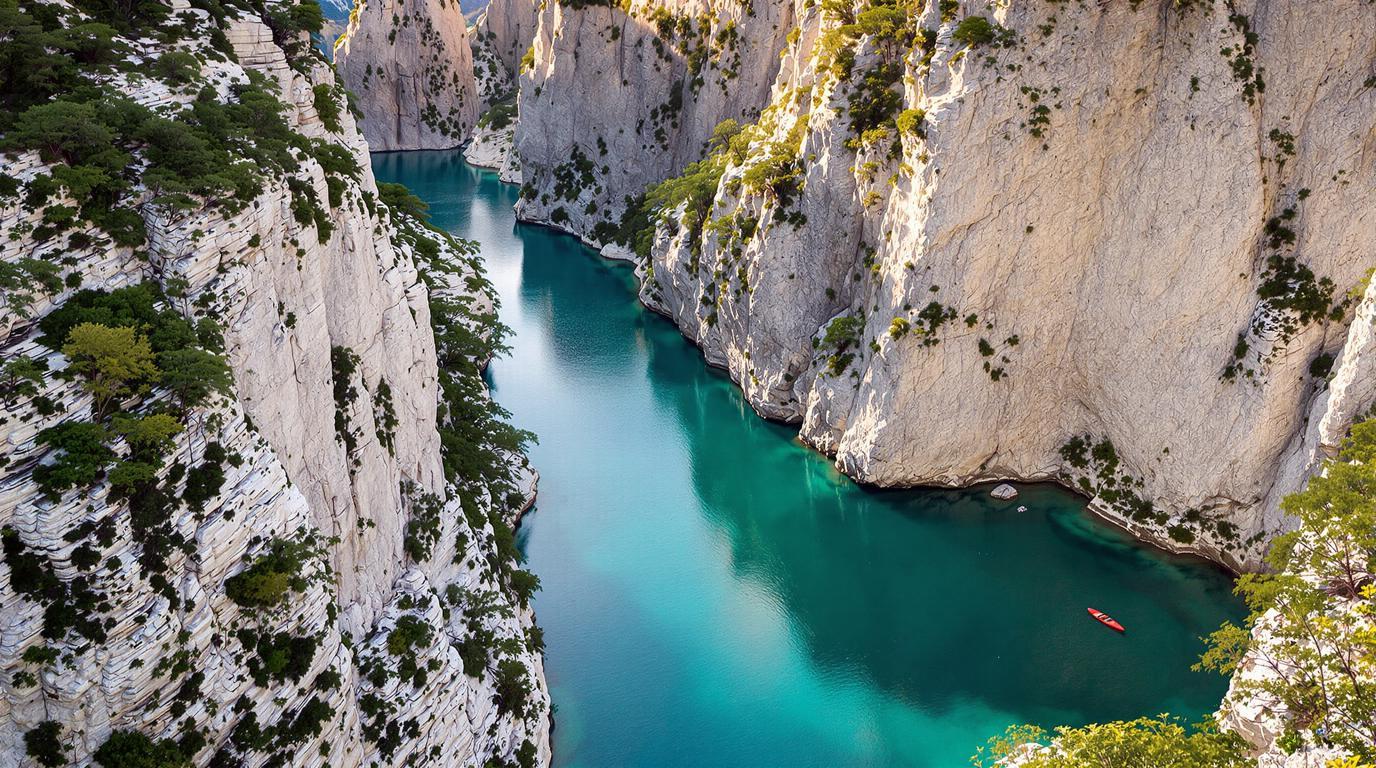France’s Verdon Gorge: Europe’s Most Spectacular Canyon Reveals Turquoise Waters and Dizzying Cliffs
A river carved masterpiece hiding in Provence
The Verdon River has spent millennia carving one of Europe’s most breathtaking natural wonders. Located at 43.7486° N, 6.3289° E in France’s sun-drenched Provence-Alpes-Côte d’Azur region, the Gorges du Verdon stretches nearly 15 miles with limestone walls plunging up to 2,300 feet to the startling turquoise waters below. This geological marvel makes the Grand Canyon’s European cousin a paradise for adventurers and nature lovers alike.
The otherworldly blue-green waters that captivate photographers
What immediately strikes visitors is the surreal color of the water – a luminous turquoise that seems almost artificially enhanced. This distinctive hue results from microscopic limestone particles suspended in the glacial waters, creating what locals call “eau d’emeraude” (emerald water). The effect is most dramatic when summer sunlight penetrates the narrow canyon, illuminating the river like a neon ribbon cutting through the white limestone.
“The first time I saw that water, I thought someone had played a trick with food coloring. It’s nature’s perfect swimming pool,” says Pascal Faudou, a local climbing guide who has explored the gorge for over 20 years.
The charming medieval village that serves as the perfect basecamp
The picturesque town of Castellane sits at the gateway to the gorge, its narrow streets and honey-colored stone buildings clustered around the impressive Chapelle Notre Dame du Roc. Perched on a 600-foot limestone outcropping, this chapel provides spectacular panoramic views of the gorge and surrounding mountains. The village’s Wednesday market offers regional cheeses, lavender honey, and olive oils that capture the essence of Provence.
A paradise for thrill-seekers with cliffs demanding respect
Rock climbers from around the world flock to the Verdon’s legendary routes. With over 1,500 established climbs on pristine white limestone, the gorge has earned the nickname “the birthplace of modern sport climbing.” For water enthusiasts, kayaking or canoeing through the narrow passages offers a perspective few get to experience – looking up at towering walls from water level while navigating gentle rapids.
The scenic drive that rivals California’s Pacific Coast Highway
The “Route des Crêtes” (Ridge Road) delivers jaw-dropping vistas from numerous pull-offs, each revealing another impossible angle of the canyon. This 15-mile loop from La Palud-sur-Verdon provides the gorge’s most spectacular viewpoints, including the famous Point Sublime. Visit at sunrise when the first light illuminates the eastern walls, turning them gold while the canyon floor remains in shadow.
Hidden beaches and swimming holes known only to locals
While tourists flock to the larger beaches of Lac de Sainte-Croix (the artificial lake at the gorge’s western end), locals prefer secluded spots like Plage de Chabassol – a hidden pebble beach accessible only by boat or a challenging hike. Here, you can swim in the refreshing turquoise waters surrounded by towering cliffs with far fewer crowds.
“We Provençals keep some secrets to ourselves,” laughs Mathilde Laurent, who runs kayak tours in the gorge. “But I’ll tell you this – the best swimming spots are found by paddling upstream from Pont du Galetas in early morning.”
Why this French treasure rivals the world’s natural wonders
The Verdon Gorge combines elements that make it uniquely captivating – the Mediterranean climate provides reliable sunshine, the limestone creates both striking white cliffs and that impossible water color, and the French location ensures excellent infrastructure and culinary experiences nearby. Unlike Victoria Falls’ thundering waters, the Verdon offers serene beauty alongside its dramatic landscapes.
When to visit for perfect conditions without the crowds
Mid-May to mid-June offers the ideal balance of warm temperatures, flowing water, and manageable crowds. September is equally rewarding as summer visitors depart but the Mediterranean warmth remains. Avoid August when French holiday-makers fill every corner. Like planning for the Northern Lights, timing your visit properly transforms the experience entirely.
The underground wonder you shouldn’t miss
Few visitors realize that beneath the dramatic surface landscape lies the fascinating Grotte de Sainte-Baume, a limestone cave system with stalactites and stalagmites formed over millions of years. While not as extensive as Turkey’s underground cities, these caves provide a cool respite from summer heat and an intriguing glimpse into the region’s geological processes.
Provençal lavender fields that complement the gorge experience
Time your visit between mid-June and mid-August to witness the purple majesty of Provence’s legendary lavender fields in nearby Valensole. The contrast between these orderly purple rows and the wild drama of the gorge creates a perfect photography pairing that rivals the visual impact of the Philippines’ hidden sandbars.
“The Verdon Gorge is Provence’s crown jewel,” says renowned landscape photographer Jean-Michel Lenoir. “It’s where nature’s drama meets French elegance – nowhere else combines these qualities in quite the same way.”
France’s unexpected adventure capital awaits
The Verdon Gorge offers that rare combination of accessible wilderness and refined culture. Here, you can spend mornings scaling limestone walls or paddling turquoise waters, afternoons exploring medieval villages like Europe’s spectacular cliff-top fortress towns, and evenings savoring Provençal cuisine under star-filled skies. This isn’t just another pretty European landscape – it’s nature’s perfect playground wrapped in French sophistication.
